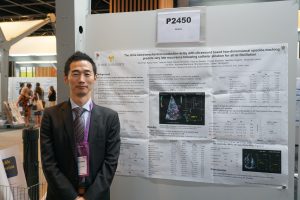ESC Congress 2019
2019年09月04日
医局ブログの記事一覧
8月31日から9月4日までヨーロッパ心臓学会学術集会(ESC Congress 2019)がフランス パリで行われました。当科からも山口教授をはじめ、井上先生、上谷先生、藤井先生、東先生が参加し、下記の研究内容を発表いたしました。
現在、オーストラリア メルボルン大学に留学中の川上先生とも合流し、お決まりの集合写真です。。
川上先生は今回2つのOral presentationをこなされました。がんばってます。
学会初日は喜多医師会病院 斉藤先生がModerated e-poster presentationにて発表されています。
 Saito et al Prognostic value of relative apical sparing pattern of longitudinal strain in patients with severe aortic stenosis
Saito et al Prognostic value of relative apical sparing pattern of longitudinal strain in patients with severe aortic stenosis
2日目は Imaging the left atrium: What’s New (poster presentation)では井上先生、藤井先生、東先生が発表、左房の研究は愛媛大学にあり!
A Fujii et al. The atrial electromechanical conduction delay with ultrasound based two-dimensional speckle-tracking predicts very late recurrence following catheter ablation for atrial fibrillation.
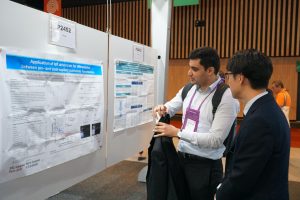 K Inoue et al. Application of left atrial strain for differentiation between pre- and post-capillary pulmonary hypertension
K Inoue et al. Application of left atrial strain for differentiation between pre- and post-capillary pulmonary hypertension
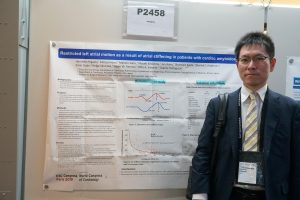 H Higashi et al.Restricted left atrial motion as a result of atrial stiffening in patients with cardiac amyloidosis
H Higashi et al.Restricted left atrial motion as a result of atrial stiffening in patients with cardiac amyloidosis
3日目は 川上先生がOral presentation、再び喜多医師会病院 斉藤先生がModerated e-poster presentationにて発表。午後からは井上先生が発表されています。
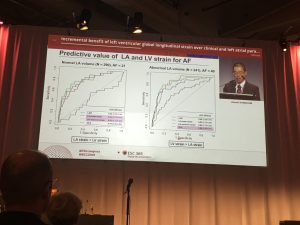 Kawakami et al. Incremental benefit of left ventricular global longitudinal strain over clinical and left atrial parameters for predicting new-onset atrial fibrillation (3224)
Kawakami et al. Incremental benefit of left ventricular global longitudinal strain over clinical and left atrial parameters for predicting new-onset atrial fibrillation (3224)
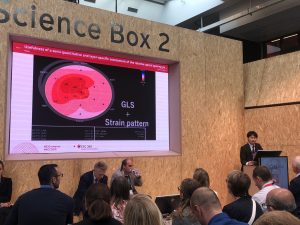 Saito et al. Usefulness of a semi-quantitative and layer-specific assessment of the relative apical sparing pattern of longitudinal strain for the identification of cardiac amyloidosis (3078)
Saito et al. Usefulness of a semi-quantitative and layer-specific assessment of the relative apical sparing pattern of longitudinal strain for the identification of cardiac amyloidosis (3078)
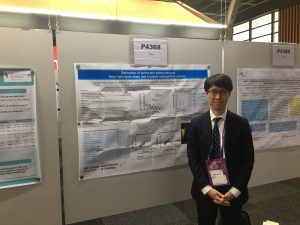 K Inoue at al. Estimation of pulmonary artery pressure from right atrial strain and tricuspid regurgitation velocity
K Inoue at al. Estimation of pulmonary artery pressure from right atrial strain and tricuspid regurgitation velocity
4日目は川上先生がModerated e-poster presentation、上谷先生がPoster presentationにて発表を行いました。
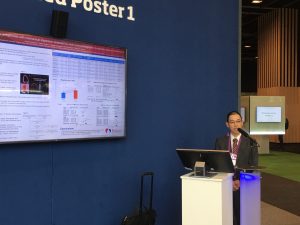 Kawakami et al. Prediction of ventricular arrhythmias with mechanical dispersion assessed by strain echocardiography: A systematic review and meta-analysis.
Kawakami et al. Prediction of ventricular arrhythmias with mechanical dispersion assessed by strain echocardiography: A systematic review and meta-analysis.
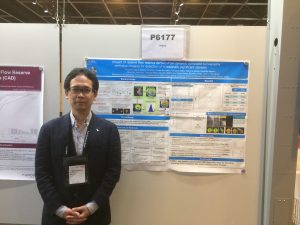 T Uetani at al. Impact of relative flow reserve derived from dynamic computed tomography perfusion imaging for detection of functionally significant stenosis
T Uetani at al. Impact of relative flow reserve derived from dynamic computed tomography perfusion imaging for detection of functionally significant stenosis


